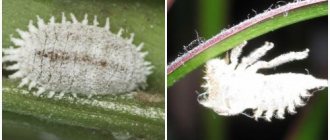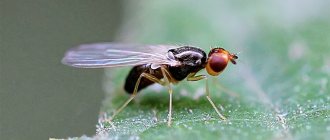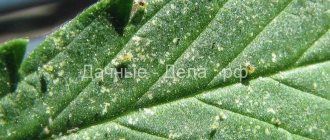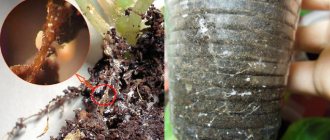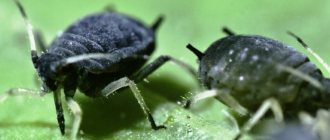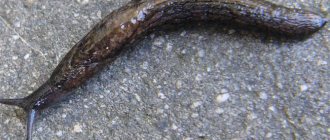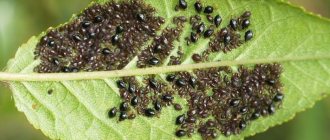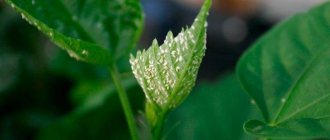Author: Elena N. https://floristics.info/ru/index.php?option=com_contact&view=contact&id=19 Category: Plant Pests Published: November 07, 2017Last edits: October 26, 2020
- Mealybug on grapes
Mealybugs (lat. Pseudococcidae), or pseudocushions, or felt insects, represent a family of hemipteran insects, including more than 2,200 species. Only 330 of them are found in Europe. The mealybug is a widespread insect that damages food, greenhouse and indoor plants, including cacti and succulents. People call these pests “hairy lice.”
Mealybug pest - description
The mealybug has a characteristic appearance and is large in size compared to other insects, but an inexperienced gardener may not immediately detect the onset of the invasion, which greatly complicates the fight against the pest.
The length of the mealybug can reach from 3 to 10 mm. Females and males differ significantly in appearance. The female pest has an oval body covered with white powdery wax, she has many short legs and long thread-like antennae. The scale insect larva is similar to the female, but smaller in size. And males are winged insects that resemble flies or mosquitoes. They do not have mouthparts, do not feed on plants and do not harm them.
What are the harms of mealybugs? These are sucking pests that feed on cell sap, which first leads to a slowdown and then to a complete cessation of plant growth and development. During their life, mealybugs secrete honeydew, or honeydew - a sweet and sticky liquid, which is a favorable environment for the development of various fungal diseases, in particular sooty fungus. The mealybug pest damages all organs - both ground and roots, and easily moves to neighboring plants.
- Apple tree: diseases and pests and their control
Of the many species, the most famous are the greenhouse plate, bamboo, citrus, seaside, grape, Australian grooved, root, bristle and Comstock bugs.
Types of Mealybugs
Bristle Mealybug
Bristle mealybug (Pseudococcus longispinus) - females and larvae harm plants. The body of an adult female is 3.5 mm long, oval in shape, orange or pinkish in color, covered with a white coating. The scale insects have well-developed legs, thanks to which they can easily move from plant to plant. Females are viviparous. They usually accumulate in the form of colonies on the underside of leaves, on branches, in leaf axils and on young shoot tips.
The bristlebug is a fairly large insect, easily noticeable on the plant due to the white powdery coating that covers its body and the white waxy formations in the form of cotton balls. Damaged leaves turn yellow and fall off. Shoots are stunted in growth. Scale insects crawl under the bark of citrus fruits and under the scales of bulbs of bulbous plants. Plants damaged by scale insects are severely depressed, stunted in growth, leaves turn yellow and fall off. Sooty fungi can settle on the secretions of scale insects.
Grape mealybug
Grape mealybug (Pseudococcus citri) - the body of the female is broadly oval in shape, pink or yellowish in color, covered with a white powdery coating. Legs are well developed. Males are very rare. The hatched larvae settle throughout the plant, on shoots, on leaves along the main veins. When severely damaged, scale insects form huge colonies that suck all the juices out of the plant. The leaves turn yellow, the shoots dry out. Sooty fungi settle on the secretions of scale insects.
Bristle mealybug (Pseudococcus longispinus). © Snehasis Sinha
Grape mealybug (Pseudococcus citri). © Jeffrey W
Seaside mealybug (Pseudococcus affinis). © energvmeno
Primorye mealybug
The seaside mealybug (Pseudococcus affinis) is one of the most common species of mealybug. The body of an adult female is elongated-oval, 3-4 mm long, 2-2.5 mm wide, grayish-pink in color, covered with a white powdery coating. Legs are well developed.
Males are much smaller, winged, and fly all summer. Females lay eggs in egg sacs, which are a white, fluffy, shapeless mass of waxy cobweb secretions. Typically, oviparous females hide in secluded places: cracks in the bark, in twisted leaves, in the forks of branches. The larvae are small, mobile, yellow, completely devoid of waxy coating.
They quickly spread throughout the plant and are spread by wind, humans and animals to other plants. The larvae turn into an adult insect in 1-1.5 months. By sucking out all the juices from the plant, they cause stunting and then death of the plant. Damaged plants grow poorly and do not bloom. Sooty fungi settle on the secretions of scale insects. The leaves turn yellow and fall off.
We hope that our tips for dealing with scale insects will help you! We are waiting for your comments!
Mealybug - preventive treatment
To prevent plants from being damaged by the pest, it is necessary to carry out the following preventive measures:
- regularly inspect the plants, especially the underside, leaf axils and buds ;
- promptly remove dried leaves, shoots, branches and buds that attract pests;
- observe the watering regime: moisture should be regular and sufficient;
- from time to time give indoor flowers a warm shower;
- place each new plant in quarantine , that is, keep it for at least a couple of weeks away from other indoor flowers and be sure to treat it with an insecticide for preventive purposes.
Mealybugs thrive at temperatures above 25 ºC and high air humidity, so in such conditions preventive inspection of plants should become frequent and mandatory.
How to deal with mealybugs at home
Remedies for mealybugs (preparations)
How to treat plants against mealybugs? Almost all insecticides cope with this pest, but the best of them are considered to be:
- Admiral is a hormonal insecticide with enteric contact action (active ingredient is pyriproxyfen);
- Aktara for mealybug - an insecticide with enteric contact action (active ingredient - thiamethoxam);
- Actellik is a non-systemic organophosphate insectoacaricide with enteric contact action (active ingredient – pirimiphos-methyl). Due to its high toxicity, the drug is not recommended for use indoors;
- Apploud – insecticide (active ingredient – buprofezin);
- Bankol is an insecticide with enteric contact action (active ingredient – bensultap);
- Biotlin is a systemic insecticide with enteric contact action (active ingredient – imidacloprid);
- Bitoxibacillin is a biological preparation with insectoacaricidal properties to protect plants from pests;
- Inta-vir is a broad-spectrum insecticide with enteric contact action (active ingredient – cypermethrin);
- Commander is a systemic insecticide with enteric contact action (active ingredient – imidacloprid);
- Confidant is a systemic insecticide with enteric contact action (active ingredient – imidacloprid);
- Mospilan is a systemic insecticide with enteric contact action (active ingredient – acetamiprid);
- Tanrek is a broad-spectrum systemic insecticide with enteric contact action (active ingredient – imidacloprid);
- Fitoverm is an insectoacaricide of biological origin with enteric contact action (active ingredient - aversectin).
In addition to those described, there are other effective drugs against mealybugs , for example, Dantop (Ponche, Apache), Vertimek, Spark Double Effect and Calypso.
Mealybug on orchids
Mealybugs settle on ficus, dracaena and even cacti, but most often mealybugs appear on flowers - on orchids and violets, for example. When examining your indoor plants, the following symptoms will help you determine that this particular pest has settled on them:
- How to deal with bean pests
- the plant seems to be sprinkled with a loose powdery coating;
- the flower droops, its leaves lose turgor;
- Sticky spots of honeydew form on the external organs of the plant;
- the plant is covered with oval white insects.
If you find at least one of the listed signs, immediately begin saving the flower. How to deal with mealybugs on an orchid? First of all, it needs to be isolated so that the pests do not spread to other flowers. Dilute 2 g of green soap in 100 ml of water and very carefully wipe the ground organs of the orchid with this solution using a sponge or cotton pad. You need to penetrate into the cracks between the trunk and leaves with a brush soaked in the solution, since pests like to settle in hard-to-reach places. Don't forget to wash the leaves from the underside. After this, you need to spray the flower three times with an interval of 7-10 days with some folk remedy (infusions of tobacco or garlic, cyclamen decoction). Only treating the orchid three times will give the desired result, although it will seem to you that the pests have disappeared after the first spraying.
Among the chemical preparations against mealybugs on orchids, Fitoverm, Inta-vir and Bitoxibacillin are the most effective.
Mealybug on violets
For violets, the mealybug is the most difficult and insidious pest. It is difficult to track the moment when the scale insect appears on violets, since almost its entire cycle takes place underground. But even when the enemy is discovered, it turns out that fighting him is not so easy: he is ideally protected by the structural features of his body.
In the fight against mealybugs on violets, do not waste time trying to cope with the pest with folk remedies, but immediately use systemic insecticides. It is best to treat violets with Actellik: 2-3 sprayings at weekly intervals with a solution of 2 ml of the drug in 1 liter of water will destroy insects of all stages of development, except eggs. However, plant treatment should be carried out outdoors. If after this, scale insects appear on the violets, you will have to remove each plant from the pot, clean the roots from the soil, carefully treat the stem, axils of the lower leaves and the roots of the violet with a systemic insecticide, and then plant the plant in a fresh substrate.
Mealybug on cacti
If your cactus suddenly began to grow slowly, but you did not find any pests on it, this does not mean that there are none: you must definitely inspect the root system of the plant. Usually, scale insects suck the juice from the fresh growth of the tops of cacti and other succulents, but at the same time they can be found on the roots at the base of the stem and in the earthen coma. Signs of the harmful activity of mealybugs on a cactus may include deformation of young leaves and growth points, as well as brown or reddened marks - bite sites.
To kill mealybugs on cacti, you will need 3 treatments of the above-ground parts of the plants with a systemic insecticide at intervals of 10-15 days. During each spraying, it is necessary to spill the insecticide solution on the soil in which the cacti grow.
Hot water has a very effective effect on the pest: the plants are removed from the pots and washed under running water at a temperature of 45-50 ºC, mechanically removing pests from them and washing the roots from the ground. After washing, the cacti are completely immersed in a solution of a systemic insecticide for several hours, then dried and planted in a fresh, disinfected substrate. Of the chemicals used to combat scale insects on cacti, Decis, Apollo, Karbofos, Fufanon, Actellik, Sherpa and preparations based on imidacloprid have proven themselves well.
- Repelling mosquitoes with plants
If there are few pests, it may be enough to treat the plant with garlic tincture. It is more convenient to do this with a cotton swab.
Mealybug on dracaena
Signs of damage to dracaena mealybugs are white bloom and spots of honeydew on the stems and leaves of the plant, loss of turgor in the leaves, the formation of brown spots on them and curvature of the stem. Mealybugs appear on the plant in conditions of too high humidity at temperatures above 25 ºC.
Mealybugs on dracaena need to be combated comprehensively, that is, in addition to treating the plant by leaves, it is necessary to disinfect the soil in which the dracaena grows. Among the chemical preparations in the fight against scale insects, Fitoverm has proven itself well, which should be used to treat the plant 4 times with an interval of 1 week. Confidor also copes well with the pest, but the most effective remedy is still Aktara: to spray dracaena on the leaves, use a solution of 4 g of the drug in 5 liters of water, and to treat the soil in a pot, you need to dilute 0.7 g of Aktara in 1 liter of water. However, whatever preparation you prefer, first try to wash off the insects from the plant or remove them using a cotton swab dipped in a soapy solution.
Description of insects
Mealybug , as seen in the photo, is a relatively large insect that can reach 5 mm in length. It has an oval body covered with a white powdery coating and bristles on the sides. Body color can be pink, white or cream. There are transverse stripes on the back.
These insects are characterized by sexual dimorphism - large differences between males and females. In males , the head, abdomen, and chest are clearly visible and the wings and paws are developed. In females , the body is devoid of clearly defined sections, has an oval, slightly elongated shape, they look like larvae.
Adult males live very little, apparently because they do not eat anything. Females are well protected from many chemicals by a waxy coating.
A characteristic feature is also its rapid adaptability to various insecticides.
Reproduction depends on the species - there are viviparous and oviparous females. The eggs are placed in a white, cotton-like facial sac. Scale insects are highly fertile, producing up to 4 generations per year. The first instar larvae are called wanderers because of their ability to actively move around the plant, and they are also carried by the wind.
Motility disappears after the insect has attached itself to the food plant. Later they molt, become second instar larvae and begin to look for a new feeding site. Some adult females can also crawl from place to place. Before laying eggs , most species hide in shelters.
Fighting mealybugs in the garden
Mealybug on grapes
If the clusters on your grapes look pale and droopy, and in some places you notice clumps of plaque that look like pieces of cotton wool, inspect the bush more closely: it may be infested with mealybugs. The fight against them must begin immediately. And keep in mind: there are no grape varieties resistant to this pest, no matter what the sellers tell you.
Preventive treatment of grapes against scale insects is carried out in early May, when females lay eggs. For spraying on leaves, systemic preparations Aktaru, Actellik, Iskra Zolotaya, Mospilan or Confidor are used. If the mealybug has already taken root on your grapes, then one treatment will not solve the problem, but if you regularly use systemic insecticides for preventive purposes, then one spray may be enough.
If you have ants on your property, you should definitely get rid of them, as they spread scale insects throughout the garden in the same way as aphids.
In the fall, before preparing for winter, remove the old bark from the grape bush affected by scale insects and burn it along with the pests.
The fight against mealybugs on other garden plants is carried out using the same methods, including preventive measures.
Reasons for appearance
Mealybug infestations can occur at any time of the year, but are more likely to occur in late summer and fall.
If the plant is not properly cared for, there is a risk of mealybugs appearing.
The causes of scale insects are quite varied and include:
- low room temperature;
- waterlogging of the soil used;
- untimely removal of dead areas of plants;
- using contaminated soil or transplanted plants.
Without timely prevention, these pests can reproduce in warm rooms almost all year round.
Fighting mealybugs with folk remedies
If berry plants are slightly affected by mealybugs, it is better to use folk remedies that are less toxic than chemical insecticides:
- oil remedy: mix 2 tablespoons of olive oil in 2 liters of water and apply this emulsion to the above-ground parts of the plant with a spray;
- Horsetail Tincture: This drug is sold over the counter and is used as a diuretic and blood purifier. Treat plants with horsetail tincture using a cotton swab;
- alcohol solution with soap: dissolve 1 g of liquid soap and 10 ml of denatured alcohol in 1 liter of warm water;
- garlic infusion: 4-5 crushed cloves of garlic are poured into 500 ml of boiling water, the mixture is allowed to brew for 4-5 hours, filtered and immediately used to spray plants;
- garlic tincture: pour one part of chopped garlic with three parts of seventy percent alcohol and treat the plant with this composition using a cotton swab;
- citrus infusion: 50 g of orange, tangerine and lemon peels are poured into 1 liter of warm water, infused for 24 hours, filtered and immediately used to spray the affected plants;
- calendula tincture: 100 g of dried calendula flowers, pour 1 liter of water, leave for a day, then filter and wipe the infected areas with the infusion;
- hot water: the plant is removed from the pot, its roots are cleaned from the ground, then completely immersed for 15 minutes in water at a temperature of 45-55 ºC, then dried and replanted in a fresh, disinfected substrate.
However, we do not recommend relying heavily on folk remedies, since they are effective only against a small number of pests, at the initial stage of infection and for prevention purposes. If there are a lot of mealybugs, do not waste time and immediately begin treating the plant with a systemic insecticide.
